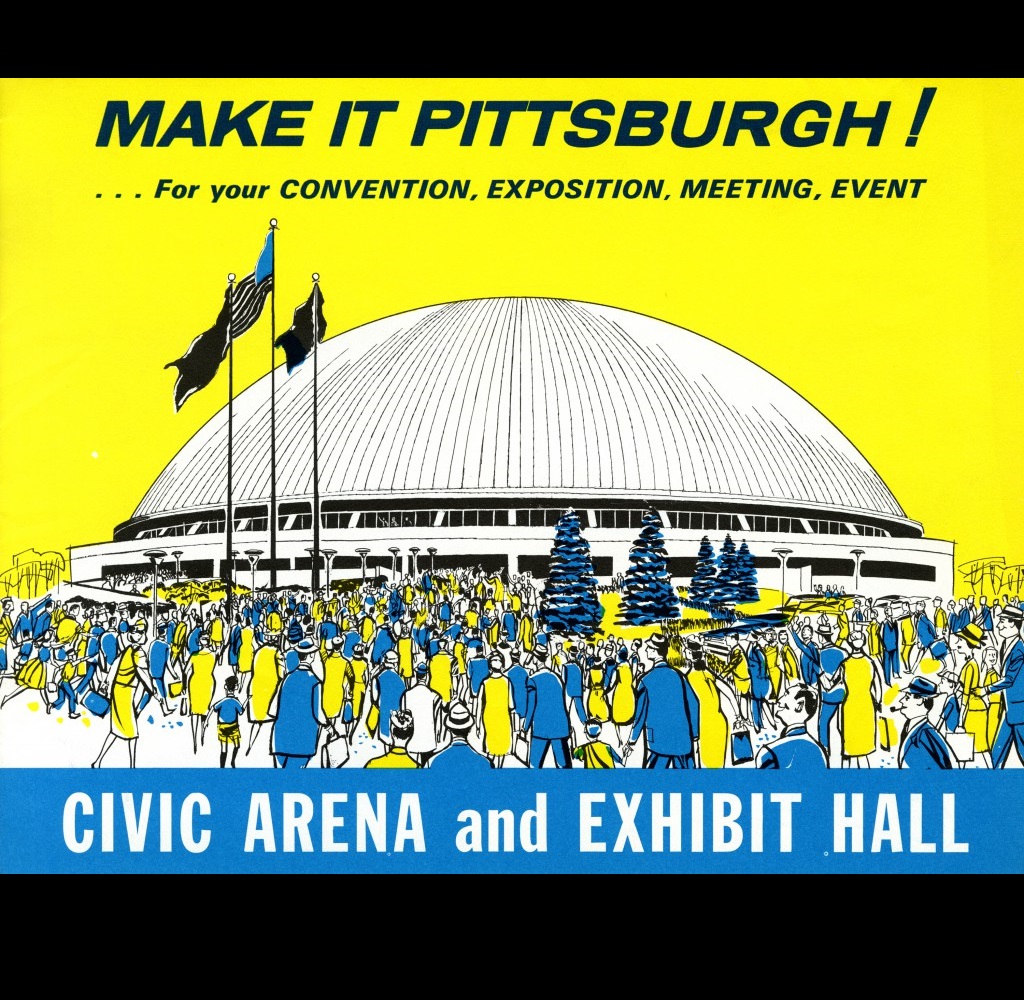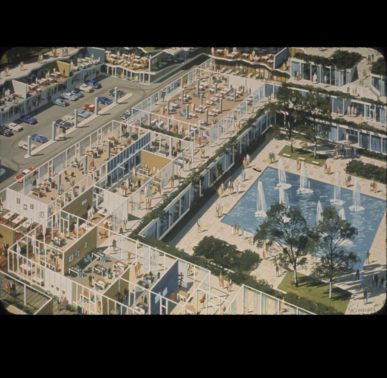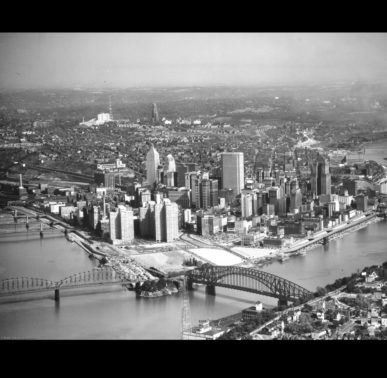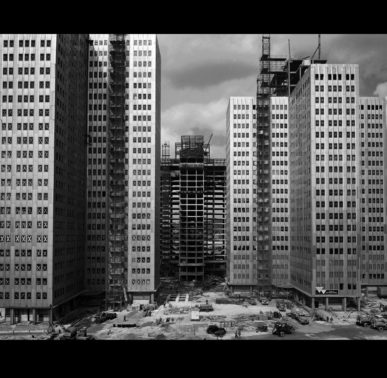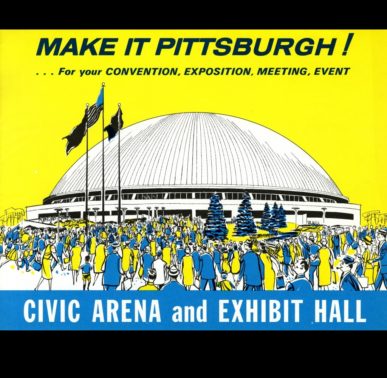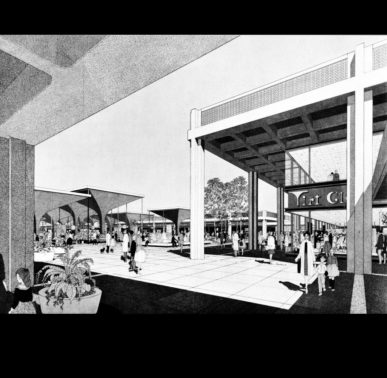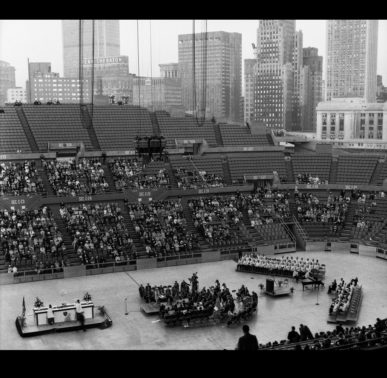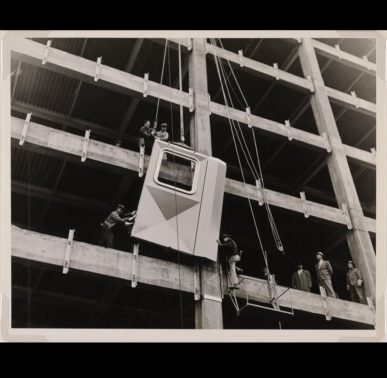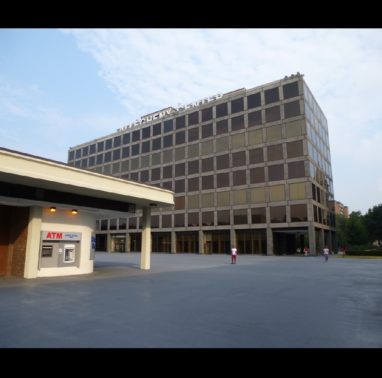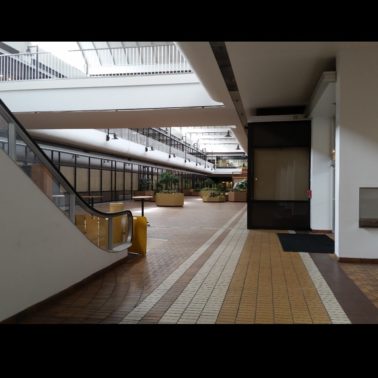Urban Redevelopment Authority of Pittsburgh; Helmut Jacoby, renderer; Illustration from Allegheny Center: From a Rich Heritage, a New Way of Life… (brochure), c. 1962; Allegheny Center; Deeter & Ritchey, architect; Courtesy of Carnegie Mellon University Architecture Archives
By Roslyn Bernstein
For a native New Yorker, the geography of Pittsburgh is something of a challenge. We are conditioned by our city: uptown is north and downtown is south. In Pittsburgh, though, if you study the map, uptown is east and downtown is west and the tangle of three rivers—the Monongahela and the Allegheny converging to form the Ohio River—results in a hilly landscape of North Side and North Shore and South Side and South Shore neighborhoods, connected by 446 bridges, more than Venice, which only has 409.
Known as “The City of Bridges” and “The Steel City,” Pittsburgh saw early and rapid industrial growth in the downtown area and along the riverbanks that strengthened its economy but resulted in citywide environmental and social catastrophes. Most notable among them was the dark smoke that hung over the city, keeping out the sunlight and covering everything, buildings and people alike, with a layer of soot.
After World War II, Pittsburgh politicians, civic leaders and architects embarked on a brave program of urban revitalization. For two decades in the 1950s and 1960s, they turned their lens on urban planning and architecture, convinced that only an alliance of the three forces could save their town. The result of their efforts, the First Renaissance era, transformed vast sections of the city, serving as a model for development of many other US cities, including Chicago, Cleveland, Detroit, and New York.
Pittsburgh proved to be a leader, providing a modernist template for other American cities that sought to reverse the flight to the suburbs, which resulted in population decline and loss of tax revenues in the city centers. With help from the federal government, urban renewal projects sprouted up in vast areas of the city—in The Point, the Golden Triangle, the Lower Hill, Allegheny Center, Oakland and East Liberty. Under the leadership of Mayor David L. Lawrence and banker Richard King Mellon, industrial buildings at the prime real estate where the three rivers converged were demolished and Point State Park was built. New highways and parks altered the infrastructure, and new buildings, mostly commercial but also civic and residential, transformed the architectural landscape. The Renaissance did not stem the flight to the suburbs, but it did create a vibrant commercial and civic city. From the mid-‘70s through the ‘80s, under Mayor Richard S. Caliguiri, a second Renaissance saw the development of many large corporate skyscrapers. Today, spurred by the growth of the Tech and Health Care industries, the city is again seeing a flurry of construction activity, much of which is bringing residents back to the center city.
Why not make a couple of exhibitions that are laboratories, he thought. Why not choose a really big subject: Post War Urban Modernism?
I first came to Pittsburgh a few months ago with my husband, who is part of a group with Crow Hill Development of Brooklyn that has purchased the former Boys’ and Girls’ Club in the Lawrenceville neighborhood, and is in contract to buy three office buildings, including the 1958 Research Facility, part of the former Heinz office and factory complex on the North Side. It was then that I heard of the show at the Carnegie Museum of Art exploring the urban renewal movement and modernist architecture of the city.
An investigation of Pittsburgh’s post-war transformation—its post-war urban modernism, which was lauded at the time but which has had a contentious history and has sometimes been less than successful—was very much on the mind of Raymund Ryan, Curator of the Heinz Architectural Center (HAC) at the Carnegie Museum of Art (CMOA). After 12 years of exhibiting three traditional shows annually in the 4,000 square-foot dedicated space, Ryan wanted to shake things up and “get off the treadmill.” His goal was to try to be more engaging, more assertive, and more proactive. Why not make a couple of exhibitions that are laboratories, he thought. Why not choose a really big subject: Post War Urban Modernism? Why not run the HAC Lab almost eight months, from September 12 to May 2?
Ryan decided to bring in folks who knew how to do this: an innovative team of Boston-based architects and designers, over, under, who had done an exhibit and written a book, HEROIC, on the concrete architecture of post-war Boston. The team, including principals Chris Grimley, Michael Kubo, and Rami el Samahy, worked with Ryan and with Martin Aurand, the Architectural Librarian and Archivist at Carnegie Mellon University (CMU) to research, design, and install the show. Their thrust: to unearth what happened in layers, creating an exhibit that was intended as an archeological dig into the archives and artifacts of the city’s modernism and to provoke discussion on what worked, what didn’t, and what should be done moving forward.
“Maybe we are just contrarians,” said Rami el Samahy, who is also an Associate Teaching Professor at CMU, “but we just like to see things that people hate, see the modernist layer as one of the layers.” We were walking through the exhibit, watching the final flurry of installation activities before its evening opening. El Samahy explained that there have been two main historical critiques of urban modernism, first, that it is “plain ugly and inhospitable for human habitation,” and second, that “urban planning eviscerated the traditional city fabric.” “In Pittsburgh,” he said, “some of the infrastructure that was inserted created problems for normal folks to go about their lives.”
As a radical departure, the HAC Lab show has three entrances, doors decorated with vinyl decals of tripods, and can be viewed in any order. Two of the doors open from art galleries at either end of a long corridor. The third, from a mezzanine in the Hall of Sculpture, leads into a short corridor intersecting the long corridor. One opening in the short corridor connects to the Lab room. On the other side, an opening leads to three interconnected rectangular galleries.
In the long corridor, the West Wall (installed on a blue background), provides an introduction to the national context of urban renewal in the postwar era. The wall focuses on major interventions that are grouped according to biological metaphors for the city: its transportation and infrastructure as “Lungs and Arteries,” its civic and cultural spaces “The Heart of the City,” and neighborhoods with new housing are the “Cells and Tissue.” Noted here, are St. Louis’s “four vast housing projects,” including the notorious Pruitt-Igoe development, which opened in 1955 and was demolished starting in 1972, along with other efforts in Pittsburgh in East Liberty, Allegheny Center, and the Hill District.
Prominently featured in the center of this wall are two Pittsburgh urban renewal documents. The first is Pittsburgh in Progress (1947), sponsored by department store magnate Edgar J. Kaufmann. Kaufmann was a major patron of modern architecture in Pittsburgh; he commissioned Frank Lloyd Wright’s Point Park proposals (which were never built) and brought in Robert Moses to help plan the highways in 1939. Produced by the local architectural firm of Mitchell and Ritchey, even the graphics of the brochure spoke to its modernist sensibility. Featuring space-age renderings, it envisioned a city filled with modernist high-rises, acres of park space, and a monorail system, with major urban renewal development projects for the Lower Hill, Point Park, the Northside (later Allegheny center), and Panther Hollow.
On the panel opposite Pittsburgh in Progress is a second document from the same year: Pittsburgh—Challenge and Response, which described the goals of the Allegheny Conference on Community Development, chaired by Richard King Mellon. Unlike the more modernist more visionary thrust of Pittsburgh in Progress, Pittsburgh—Challenge and Response had specific answers to the “problems of smoke, blight, housing garbage, pollution, boredom, traffic congestion, and floods.”
“It was all done for suburbanites who never came.”
On the East corridor wall, the background is red and the focus is on urban renewal and modernism in Pittsburgh. In the center of the wall is a current map of Pittsburgh with six neighborhoods highlighted as study areas: The Point, The Golden Triangle, Lower Hill, East Liberty, Oakland, and Allegheny Center. Adjacent panels illuminate development in each of the areas. Point State Park and the Gateway Center opened in The Point, which was also home to the IBM Building and the steel Westinghouse Building. In Pittsburgh’s downtown Golden Triangle, modernist buildings included the Alcoa Building and two US Steel buildings, each designed by Harrison & Abramovitz. In Lower Hill, land was cleared for the construction of the Civic Arena, which proved to be a failure as a cultural mecca and was demolished in 2011. Urban redevelopment in Oakland reflected the expansion of the University of Pittsburgh. One massive project that never happened was Panther Hollow, a proposal to fill in an entire ravine situated between Pitt, the Carnegie Museums, and Carnegie Tech. In East Liberty, the Urban Redevelopment Authority (URA) played a prominent role in reducing traffic congestion and in improving housing stock.
Adjacent to the map are three diagrams, based on extensive research by Carnegie Mellon architectural historian Martin Aurand. These chart built, unbuilt, and demolished projects from the years 1945 -1975, connecting them through white lines to their architects and to their corporate, institutional, and civic sponsors. While many of the civic projects have since been demolished—including the original Pittsburgh airport, the Civic Arena, and the Children’s Zoo. Significantly, none of the corporate projects, including the Alcoa Building, the HJ Heinz Vinegar Plant (1952), the Heinz Warehouse (1975), and the Riley Research Center (1958), have been torn down. Most of the institutional buildings erected in the 1960s, sponsored by Carnegie Tech, Carnegie Mellon Library, and Allegheny Community College, are also still standing.
The most unique part of HAC Lab is the lab itself. Accessed from the long or short corridor, the room is filled with desks arranged in a tripodal pattern reflecting the three-part freestanding structures holding some of the exhibit materials. In this room, el Samahy’s 3rd and 4th year architectural students will meet and work on rethinking the Allegheny Center, which was a prime example of the failure of urban renewal and sits largely abandoned. The North Side of Pittsburgh, originally known as Allegheny City (an independent city) was annexed to Pittsburgh in 1907. Throughout the 1950s, it suffered from high crime, and was filled with derelict structures. The population declined by 25 percent. Many buildings in its historic core were razed in the years 1965-1973, and the urban renewal design plan for the area, Allegheny Center, called for building a four-lane, one-way loop of a highway around the neighborhood, with a shopping mall and underground parking.
“It was all done for suburbanites who never came,” said el Samahy, adding that “the highway cut off the center from surrounding neighborhoods.” The students’ charge is to develop contemporary design proposals for Allegheny Center. El Samahy sees his students’ efforts as almost a performance piece. “The public will be invited to come in while the class is in session and their comments will be welcome,” he said.
The layers of architectural modernism in Pittsburgh are scrutinized through photography, media documents, and film.
One wall of the room is hung with historic drawings of the urban renewal era including original Frank Lloyd Wright drawings of the Point Park proposal. The other three walls are lined with Homasote, where the students will hang their work-in-progress.
The three other rooms in the exhibit peel back the layers of architectural modernism in Pittsburgh by scrutinizing photography, media documents, and film. Organized according to the perspective of different lenses, the photography room shifts from formal to informal: from the renowned architectural photography of Ezra Stoller, to the documentary photography of W. Eugene Smith, who arrived in Pittsburgh in 1955 after leaving Life Magazine, to Roy Stryker, the Information Director for the US Farm Security Administration during the Depression, who documented the Pittsburgh Renaissance with a team of 11 photographers in the 1950s, and the local Brady Stewart Studio. Also on view is the community photography of Charles “Teenie” Harris, a local photo-journalist whose photo exhibit on cars is currently being shown in the Carnegie Museum of Art, and images shot by Troy West, whose camera focused on the Hill District, the heart of African American life and of jazz in Pittsburgh. “At first, the African American community was very supportive of plans to develop the Hill,” el Samahy said. “Then they realized that they were not getting what they wanted. Overall, one of the biggest shortcomings of urban renewal was that not enough federal dollars went to housing.”
Early in the morning, the document room was filled with people wearing rubber gloves. Along the top of each wall, like a Greek frieze, was a timeline of the popular press, copies of local stories from prominent Pittsburgh newspapers. “Ideal Housing Believed Possible if Pittsburgh Enforces Slum Laws,” reads the headline from the Pittsburgh Post-Gazette of January 24, 1934. “City of Pittsburgh’s Housing for Negroes: Is the Hill District Doomed?” reads the negative headline of the Pittsburgh Courier from April 29, 1950. “Allegheny Center… Renaissance on the North Side,” is the headline from a Pittsburgh Press story of May 19, 1963. “Does Urban Renewal Mean Negro Removal?” is a bold headline from the Pittsburgh Courier of August 7, 1965.
Below the timelines of popular press stories are pieces from the architectural press, including the earliest article on Pittsburgh urban renewal in Architectural Forum, from November 1949. These do not align chronologically with the popular press stories above. Rather, most are positive features on Pittsburgh’s modernist movement. One headline sums them up: “An urban redevelopment dream is coming true in Pittsburgh,” reads the headline in the Engineering News Record for April 24, 1952.
A flakeboard cabinet, designed for the exhibit by Chris Grimley, has drawers holding issues of Architectural Record, Industrial Design, and Interior Design as well as books on landscape architecture. “Some,” el Samahy admitted with a smile, “were actually purchased on eBay.” Another case features manifestos, essays, and promotional brochures. Prominent among them is Make It Pittsburgh!, a bold blue and yellow advertisement for the now-demolished Civic Arena.
In the third room, six documentary films from 1939 to 1962 are shown in a loop. All feature themes relevant to the exhibit; some from a national perspective, some focusing on Pittsburgh’s urban renewal, and some highlighting developments in other US cities. “We chose these films because they reflect the general tenor of discussion in the postwar era, or at least the voices with access to film and television production,” el Samahy said.
While the films will change over the course of the exhibit, the current list includes a 21-minute black-and-white film from 1939’s Housing in Our Time, sponsored by the US Housing Authority of the Federal Works Agency, a 27-minute black-and-white film from 1955, Freedom of the American Road, sponsored by the Ford Motor Company, a 28-minute color film from 1956, The Dynamic American City, sponsored by the Chamber of Commerce of the United States, and a 28-minute color film from 1962, Form, Design and the City, sponsored by the Reynolds Metals Company in cooperation with the American Institute of Architects.
Experiencing the three rooms, says Rami el Samahy, is akin to feeling the parts of an elephant when you are blindfolded. “One can only hope that, for the viewer, it will all come together as the elephant.”
I exited the HAC Lab show through the middle entrance, where four artists’ visions of Pittsburgh hang on the walls. There’s Pop artist Claes Oldenburg’s vision of the Golden Triangle covered with 16 billiard balls and two color photos by Walter Seng of artist Otto Piene’s sky ballet, sculptures made of balloons. There’s Pittsburgh photographer Ed Massery’s two photos of the final days of the Civic Arena, and, there’s master photographer Ezra Stoller’s handsome black-and-white portrait of the H.J. Heinz Research Facility, designed by Gordon Bunshaft for Skidmore, Owings & Merrill in 1958. Coincidentally, looking through the glass wall of the Florence Knoll-designed lobby, one sees a large mural by artist Stuart Davis which can currently be found hanging in a contemporary art gallery adjacent to the exhibit. H.J. Heinz no longer has its research facilities and central offices there, but the glass curtain-walled building, six stories on a base of two, remains, awaiting reimagining.
Roslyn Bernstein reports on arts and culture for such online publications as
